Re: IEA source: Peak Oil is here
These things do work great, buying them online or from the TV ad is a laughable rip off though. You can make one with a 5 gal. bucket for $3. Less if you've got some buckets lying around or know someone who does. They're much more durable than the Topsy Turvey's too. Just be aware to plan ahead when you set them up, since one you put the soil/water in them they become a major PITA to move. Large hanging plants can easily weigh 60lbs or more like that.... Also make sure to cover the tops with a lid to reduce water evaporation, but don't seal them all the way so the soil can aerate.
http://www.gardeningknowhow.com/urba...-gardening.htm
http://www.gardeningknowhow.com/urba...pside-down.htm
Originally posted by ggirod
View Post
http://www.gardeningknowhow.com/urba...-gardening.htm
http://www.gardeningknowhow.com/urba...pside-down.htm





Comment